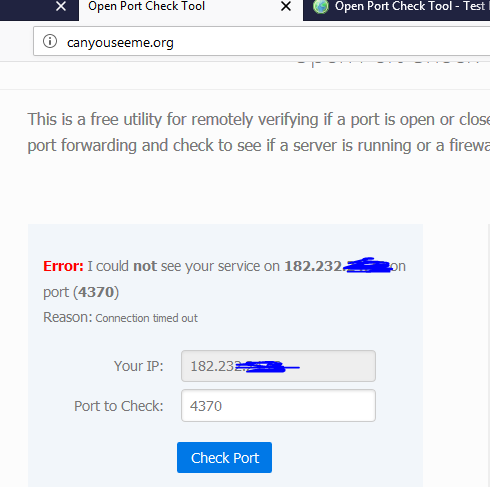

- #Port forward utility says port open Pc
- #Port forward utility says port open plus
- #Port forward utility says port open windows
The IP addresses on the Internal network are private addresses and are not routable on the Internet.Įxternal computers or devices only see the public IP address that is assigned to the NAT router Interface. On home or small office networks the router uses NAT (Network Address Translation) which allows internal devices to share a single external IP4 Address. Client port numbers are dynamically assigned and can be reused once the session is closed.
#Port forward utility says port open Pc
Our PC – IP1+port 2040 -–Yahoo IP3 +port 80 (standard port) Your PC – IP1+port 2020 -– Google IP2 +port 80 (standard port) One looking at the Google website and the other at the Yahoo website.
#Port forward utility says port open windows
Imagine sitting on your PC at home, and you have two browser windows open. See Understanding TCP/IP Ports and SocketsĪs an example.
#Port forward utility says port open plus
The combination of IP address plus port is known as a socket. e.g Web servers normally use port 80 and SMTP servers use port 25. Standard Port numbers are allocated to server services (0-1023) by the Internet Assigned Numbers Authority (IANA). The use of ports allow computers/devices to run multiple services/applications. The port identifies the application/service running on the machine. However a device can run multiple applications/services. On a TCP/IP network every device must have an IP address. You will also need to appreciate the difference between internal and external IP addresses and internal and external ports.Ī TCP/UDP port identifies an application or service on a machine in a TCP/IP network. To understand port forwarding you need to understand what a TCP/IP port is and how ports and IP addresses are used together. Most online gaming Applications will require you to configure port forwarding on your home router.

It does this by mapping an external port to an internal IP address and port. Port forwarding is a technique that is used to allow external devices access to computers services on private networks. I disabled all firewalls and protectors, etc, unless there is something in the modem I missed.What is Port forwarding ? and What Does it do? TL DR: Something is blocking my open ports. When I turn IP Passthrough off and scan a port like 80, it comes back as a timed out.

Now any port I scan is "connection refused", I am assuming because it works like a DMZ and opened all of them. All the same result - "connection refused".ģ2657 Refused (When opened specifically, they get refused.)Ĭlosed/Random Port 3277 Timed Out (This is to show that normally, ports simply time out if unopened.)ĮDIT: I tried IP passthrough on Default Server instead of off, and defined my device in the address box. PS: For the record, I've tried other ports as well. I've never had an issue forwarding ports in the 10+ years I've been using the internet. If any of you have had any experience with this ridiculous problem, let me know. I'm interested in being able to open my ports when I pay for internet, just as I've always been able to do. I've attempted to call ATT about this, and they refer me to some fee-based service that is far too expensive. I tried to use your port tool regardless, but it makes me login to the ATT website in an endless loop. ( For any of you ATT techs, my IP begins with 108, not 10. Nobody can connect to me via that port, even after opening it in the modem. When I scan a port I opened via the modem, it says "connection refused". I scan a closed port with - it says connection timed out, expectedly. I save it, apply it, and it appears in the list set for my device. I've disabled every Firewall option on the modem, as well as my computer. I forward the ports 32657 to 32659, on both UDP and TCP. I make sure it's on the correct device (my device). I go into my Motorola NVG510, head to NAT/Gaming, and forward some ports.


 0 kommentar(er)
0 kommentar(er)
